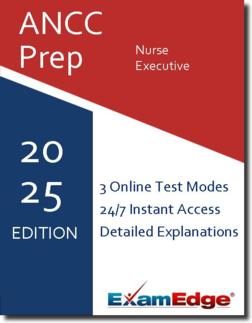ANCC Nurse Executive (NE-BC) Practice Tests & Test Prep by Exam Edge - Blogs
Based on 29 Reviews
- Real Exam Simulation: Timed questions and matching content build comfort for your ANCC Nurse Executive test day.
- Instant, 24/7 Access: Web-based ANCC Nurse Executive practice exams with no software needed.
- Clear Explanations: Step-by-step answers and explanations for your ANCC exam to strengthen understanding.
- Boosted Confidence: Reduces anxiety and improves test-taking skills to ace your ANCC Nurse Executive (NE-BC).

Exam Edge Blogs for ANCC Nurse Executive

The Best Certification for Nurse Managers: Top Picks & Benefits
While nurses are known as caretakers and versed medical professionals, they are, though less famously, often also great leaders and managers. The j...
Read More
Charge Nurse vs Nurse Leader: Roles, Responsibilities & Career Growth
There comes a point in a person’s career when it’s time to advance to jobs with more responsibility and control. The same thing happens with nurses. L...
Read More
Nurse Leader vs Nurse Manager: Key Differences & Career Paths
When choosing the next step in your career path, it’s important to understand the opportunities that are out there and what sets them apart. Sometimes...
Read More
How to Prepare for the ANCC NE Certification Exam
Feeling the pressure as you gear up for the ANCC Nurse Executive Exam? Taking this step to advance your nursing career can be daunting. If you're unsu...
Read More
NE-BC vs NEA-BC: Nurse Executive Certifications Compared
In the nursing profession, certifications serve as important milestones, demonstrating a nurse's specialized skills and commitment to career advanceme...
Read MoreExam Edge Blogs for ANCC Nurse Executive

The Best Certification for Nurse Managers: Top Picks & Benefits
While nurses are known as caretakers and versed medical professionals, they are, though less famously, often also great leaders and managers. The j...
Read More
Charge Nurse vs Nurse Leader: Roles, Responsibilities & Career Growth
There comes a point in a person’s career when it’s time to advance to jobs with more responsibility and control. The same thing happens with nurses. L...
Read More
Nurse Leader vs Nurse Manager: Key Differences & Career Paths
When choosing the next step in your career path, it’s important to understand the opportunities that are out there and what sets them apart. Sometimes...
Read More
How to Prepare for the ANCC NE Certification Exam
Feeling the pressure as you gear up for the ANCC Nurse Executive Exam? Taking this step to advance your nursing career can be daunting. If you're unsu...
Read More
NE-BC vs NEA-BC: Nurse Executive Certifications Compared
In the nursing profession, certifications serve as important milestones, demonstrating a nurse's specialized skills and commitment to career advanceme...
Read More

